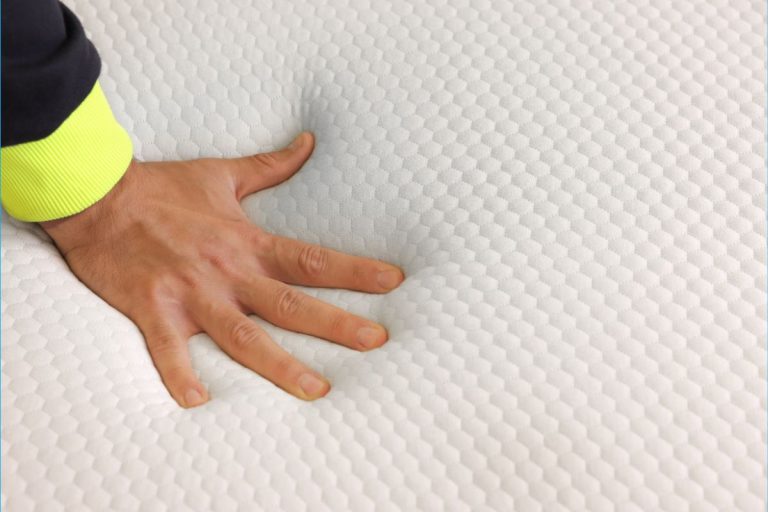Sciatica is a painful condition, that is usually triggered by the irritation of the sciatic nerve. Even though the narrative in regards to sciatica is almost non-existent, many people get affected by the painful condition.
In the past decade, the sciatica cases have doubled, and alongside scoliosis and fibromyalgia, sciatica is one of the most common and widespread conditions.
Alongside numerous difficulties sciatica patients have to deal with, almost all of them point out the fact that they cannot find a proper sleeping position that will reduce the pain and pain-related anxiety and stress.
That is why, in the following paragraphs, we’re going to take a look at the best sleeping positions for people suffering from sciatica. There are also many ways you can prevent this condition from affecting the quality of your sleep.
Hopefully, the presented information will allow you to finally get a good-quality snooze, so let’s get started!
The Anatomy of Sciatica
For those who are not familiar and want to know more, sciatica is a condition that is usually caused by the irritation of the sciatic nerve. The pain manifests itself in the lower back, so many people confuse it with strained muscles and other injuries.
Note: The main distinction between sciatica and other lower back injuries is that the sciatic pain moves to the lower legs and affects a wider region, not just the lower back. Sciatica usually affects one side of the lower back or one leg.
Such pain distribution makes sleep more complicated, so it is not uncommon that people with sciatica also develop sleep disorders, like interrupted sleep or sleep anxiety.
What Causes Sciatica?
Based on research from the National Institutes of Health (NIH), sciatica is caused by the irritation of the sciatic nerve, a herniated disc (with nerve root compression), lumbar stenosis, and possibly tumors. Sciatica can be sometimes hard to diagnose, as it is often confused with other lower back injuries.
The condition is, however, often caused by serious spinal infections, spinal tumors, degenerative disc diseases, muscle spasms, or pregnancy. Furthermore, sciatica can be caused by more serious conditions that require immediate medical attention, such as spondylolisthesis, Cauda Equina Syndrom, etc.
All of these conditions have this in common; they affect the lower back, the spine, and the nerves in this area, causing extreme pain, nerve damage, deterioration of the spinal column, bones or muscles, and much more.
Best (And The Worst) Sleeping Positions for Sciatica
Finding the right sleeping position when suffering from sciatica can be a rather difficult task. Since you’re probably feeling pain on one side, you need to adjust not only your sleeping position but also the sleeping environment to avoid putting to much pressure on other body regions. That is why research has shown particular sleeping positions to be perfect for sciatica patients;
1. Sleeping on the back: Best one for sciatica patients
Sleeping on the back is considered to be the best one for sciatica patients. Because the pain comes from the irritated sciatic nerve, it is important to reduce the pressure from the area where the sciatic nerve is located; the lower back and the lumbar discs. For that reason, sleeping in the supine position is perfect.
To achieve this sleeping position, you will need to lie on your back, making sure your whole body is resting and is in contact with the bed. Then, you will elevate your knees and place several pillows beneath them.
Place as many pillows as you find comfortable, so long you’re feeling supported and not in pain. If you find it difficult to sleep in this position, make sure to place extra pillows on the side of the back, under your arms and a proper pillow under the neck.
Note: you can add a small, soft pillow or a cushion under the hips or lower back to ensure less stress on these ligaments, joints, and nerves in this area.
2. Sleeping on the side: Second-best
The second-best sleeping position for sciatica patients is sleeping on the side. It is believed that sleeping on the side can provide the necessary relief from the pain, as well as that it can reduce the pressure on the lower back.
Because you’re not sleeping directly on your back, there is no pressure on the muscles, disc, and the sciatic nerve. However, for this position to be beneficial, it is important to keep the spine aligned, the hips straight and of course, the knees curled up a little bit towards the chest.
Note: To achieve this sleeping position, make sure to lie on the side where the pain is not located; so you’ll be sleeping on the painless side. Furthermore, you will prepare a pillow for the arm support and rest, an extra pillow for the neck are and of course, pillows for between the knees.
Then, you will push the knees a little bit towards the chest, keep them bent at a 90-degree angle. Then, place the pillow(s) between the knees to decrease the pressure on the sciatic nerve.
For more support you can place a pillow under the waist area; this way you can ensure the body stays in that position the whole night, without putting extra pressure on the lower back.
3. Sleep On The Stomach: Worst
Sleeping on the stomach is the worst sleeping position for sciatica patients. This sleeping position is likely to increase the pain levels and damage to the nerve. Even if you’re not suffering from sciatica, you should avoid sleeping on the stomach.
Note: Sleeping in this position might cause more damage to your lower back and cause your natural spinal curvature to flatten. Not to mention that there is extra tension on the sciatic nerve, neck muscles, shoulders, etc.
Sleeping on the stomach has also shown to contribute to cases of herniated disc and overall damage and injury to the lower back nerves and muscles.
Sciatic Pain During Sleep: 3 More FAQs
Why Does Sciatic Pain Worsen When Lying Down?
Sciatic pain may worsen when lying down for numerous reasons.
For example, there might be extra pressure on the lower back because the lower back tends to curve inwards more than it usually does.
Furthermore, lying down can cause pinching to the sciatic nerve, which helps the pain spread from the lower back to the thighs.
The body gets used to certain lower back positions during the day, so when you go to bed and lie down the pain becomes accentuated.
That is why it is essential to use pillows as additional support for your lower back, as well as for the knees and legs.
Why Is The Sciatic Pain Spreading Towards The Legs?
One of the most common symptoms or results of an irritated sciatic nerve is the sharp pain spreading down the legs (or one leg in this case). The reason this happens lies in the fact that because of the, pain you’re holding your back and spine in a certain position for a longer time.
For example, if you lie on your back the whole night, without any support or elevated legs, you’re blocking the nerve roots exits in the spinal column. Because of this, the nerves are being additionally pinched which directly results in lumbar spinal stenosis, also known as the sciatic leg pain.
What Are The Best Sleeping Tips For Sciatica Patients?
For the recommended sleeping position to be effective, you still need some things to improve the situation and get better sleep;
- Invest in a good mattress – this is a regular recommendation to all patients suffering from back problems; sciatica patients in particular. A good mattress can play an important role in the healing process and pain relief. Make sure to invest in a medium-firm mattress that supports your back, hips, neck, shoulders, and knees; all the pressure points in the body. This will help decrease pressure on the lower back and the sciatic nerve.
- Try sleeping on the floor – some sciatica patients have stated that sleeping on the floor has helped them a lot in their fight against sciatica. Of course, it is not recommended by experts to do this, but you can try sleeping on a yoga mat or a towel on the floor. It will be hard at first to adjust to this position and sleeping location, but give it a few tries. You might feel levels of pain being alleviated, or they can be completely gone. Make sure to still have appropriate pillow support for your legs, back and neck. If you don’t feel comfortable in this position even after several nights, then return to your bed, of course.
- Use pillows for extra support – regardless of whether you use a body pillow, small pilows or cushions, having extra support is always good when dealing with sciatica. Pillows are there to support not only the painful area but also other body parts in different sleeping positions. Pillows ensure there is no pressure on the lower back as well as other pressure points in the body. Use pillows that are soft, possibly made of memory foam to adjust to your body and the posture during sleep.
- Exercise lightly before sleep – doing back exercises before sleep can reduce the pain and make it easier to fall asleep. People with sciatica are recommended to do mild exercises and stretching. The exercises you can try include hip exercises, knee, and glute stretching, outer hip stretching, seated stretching, and the so-called child’s pose (stretching in a kneeling position).
- Enjoy a warm bath before sleep – a warm bath can reduce sciatica-caused pain significantly. So, to get a pain-free good night’s sleep, make sure to take a warm bath right before bedtime. A warm bath stimulates the release of endorphins and relaxes the muscles in the lower back and the legs. It also makes you relaxed enough mentally and makes you more sleepy.
Final Word
Sciatica is truly a terrible, painful condition that unfortunately, more and more people have to deal with. We hope that the information we presented is going to be helpful for the sciatica patients out there.
However, we do advise you to consult with your doctor or medical professional before utilizing any of the recommendations regarding sleeping positions and other tips for sleeping with sciatica. It is important your doctor sees whether and how these recommendations apply to your case. We don’t want you to cause more damage and pain to yourself.
More Resource Related to Sciatica :




